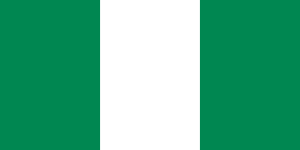
| Colors | HEX Code | RGB | CMYK |
|---|---|---|---|
| Green | #008751 | 0, 135, 81 | 100, 0, 40, 47 |
| White | #FFFFFF | 255, 255, 255 | 0, 0, 0, 0 |
The Nigerian flag is a bicolor with three equal vertical stripes. The stripes to the left and right are green (Hoist and fly sides), while the central stripe is white.
Meaning of the Nigerian Flag
The green color in the Nigerian flag is for natural wealth and agriculture, and the white represents peace and unity. The colors of the flag also symbolize Nigeria’s hope for a prosperous and peaceful future.
History of the Nigerian Flag
Nigeria was made up of several states where the slave trade was active in the 17th century. The British ruled these states and turned them into protectorates, and the Union Jack was the flag raised in these areas. In 1914, Nigeria was established by joining these states together but was still a British colony. Nigeria had its first flag which was different from the current flag. As Nigeria was moving towards independence, a contest was held to choose the best design for the country that was pacing quickly towards independence. Out of the thousands of designs provided, Michael Taiwo Akinkunmi, a Nigerian student in London, presented a design that won the contest for its simplicity and representation of Nigeria, its nature, and different ethnic groups. It was modified by the committee to omit symbols and keep the three vertical stripes. The flag was hoisted on October 1, 1960 when Nigeria proclaimed its independence and has remained unchanged since then.